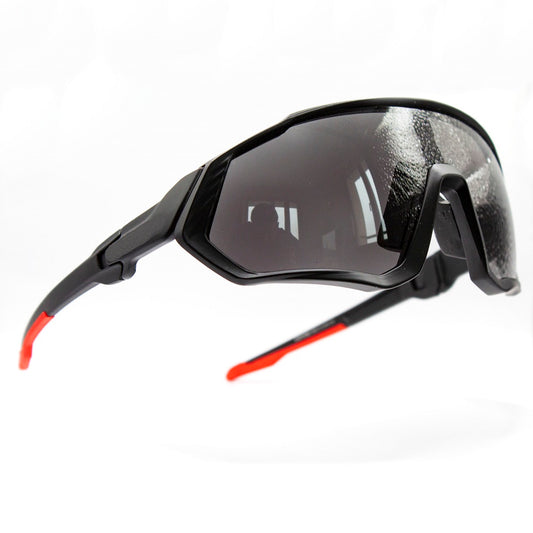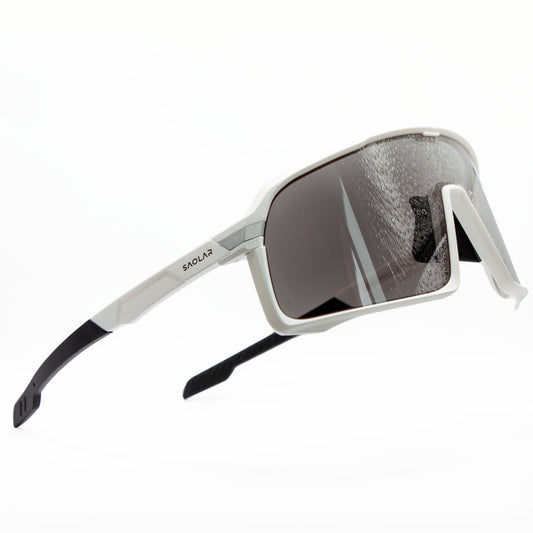The Importance of Eye Comfort for Cyclists
Cycling can be an exhilarating way to stay fit and explore the outdoors, but it comes with certain challenges—especially for your eyes. Constant exposure to changing light conditions, from bright sunlight to shaded paths, often leads to eye strain. This discomfort not only affects your cycling experience but also your overall performance. Squinting and straining to adjust to fluctuating light can be distracting, leaving you fatigued by the end of your ride.
Photochromic sunglasses provide an essential solution to this problem. Unlike traditional sunglasses, which maintain a constant tint, photochromic lenses automatically adjust their darkness depending on the level of sunlight. This dynamic adaptation reduces the strain on your eyes by minimizing glare and ensuring optimal visibility, whether you're under the blazing sun or moving through shaded trails.
Beyond just reducing eye strain, these adaptive lenses also offer comprehensive UV protection, crucial for safeguarding your eyes from long-term damage. Overexposure to UV rays can lead to conditions like photokeratitis, a painful eye condition similar to sunburn. For a deeper dive into how UV rays affect eye health, check out our detailed article on How UV Rays Cause Photokeratitis and Why Photochromic Sunglasses Are the Answer.
In summary, maintaining eye comfort while cycling is not just about avoiding short-term discomfort like squinting or headaches. It’s about protecting your vision and ensuring you can perform at your best, whether you're cycling for leisure or pushing your limits on a long ride. Photochromic sunglasses offer a perfect blend of comfort, protection, and performance enhancement for cyclists.
What Causes Eye Strain in Cycling?
Cycling often exposes riders to a variety of lighting conditions that can lead to eye strain. One of the primary culprits is direct sunlight, which can cause excessive squinting as your eyes try to adjust. This not only tires your eyes but can also reduce your focus on the road. Prolonged exposure to intense sunlight without adequate protection can lead to fatigue and even more severe discomfort over time.
Another significant cause of eye strain while cycling is glare. When sunlight reflects off surfaces like cars, wet roads, or even water, the sudden burst of light can force your eyes to work harder to see clearly. This constant adjustment between normal lighting and glare intensifies eye fatigue, often leading to headaches and reduced cycling performance.
Rapid changes between light and shadow, such as when you're cycling through wooded areas or tunnels, can also increase eye strain. Your eyes struggle to adapt quickly to these abrupt shifts, causing discomfort and distraction. Over time, these factors combine to create a taxing environment for your eyes, which can even lead to headaches.
For cyclists looking to prevent headaches and discomfort, investing in proper eyewear is crucial. Photochromic sunglasses are an ideal solution, as they automatically adjust to changing light conditions, helping to reduce glare and the overall strain on your eyes. For more tips on how to avoid headaches while cycling, visit our article on How to Prevent Headaches When Cycling with SAOLAR Sunglasses.
By using the right equipment, like photochromic sunglasses, you can significantly reduce the risk of eye strain and enjoy a more comfortable, headache-free ride.
How Do Photochromic Sunglasses Work?
Photochromic sunglasses are designed with adaptive lenses that adjust automatically to changing light conditions, offering seamless eye protection and comfort for cyclists. The technology behind these lenses involves special molecules embedded within the lens material that react to UV light. When exposed to sunlight, the lenses darken to protect the eyes, and when the light dims or you enter a shaded area, the lenses gradually become clear again.
This automatic adjustment ensures that cyclists have the optimal level of light filtering without needing to switch between different sunglasses. The adaptive nature of these lenses helps reduce eye strain caused by constantly squinting or struggling to see in varying light conditions. More importantly, they provide full UV protection, blocking harmful ultraviolet rays that can cause long-term eye damage and even conditions like photokeratitis.
For cyclists, the benefits of photochromic sunglasses are clear. They eliminate the need for frequent adjustments or lens swapping during a ride, allowing you to focus fully on the road. By reducing glare and enhancing visibility in both bright and low-light environments, these glasses improve comfort and performance. Cyclists also benefit from better protection against debris, dust, and wind, making photochromic lenses a versatile choice for any ride.
To learn more about how SAOLAR sunglasses can protect your eyes during conditions like pink eye, check out our blog on Cycling with Pink Eye: How SAOLAR Sunglasses Can Be Your Best Defense.
In conclusion, photochromic sunglasses are a must-have for cyclists, offering adaptive protection that enhances comfort, performance, and long-term eye health.
Benefits of Photochromic Sunglasses for Cyclists
Cyclists face a variety of lighting conditions during rides, which can lead to eye fatigue and decreased performance. Photochromic lenses provide significant benefits by offering adaptive vision that minimizes the need for constant adjustments to changing light. By automatically adjusting their tint, these lenses help reduce eye strain, allowing cyclists to maintain focus without being distracted by sunlight or glare.
The ability to reduce eye fatigue enhances cycling performance, as riders can maintain a clearer, more consistent view of the road without the discomfort caused by squinting or frequent lens changes. This not only increases comfort but also safety, as clearer vision enables quicker reactions to obstacles or changes in terrain.
In addition to their adaptive nature, photochromic lenses provide full UV protection, shielding the eyes from harmful ultraviolet rays, which can contribute to long-term damage and conditions like photokeratitis. Whether you're on a sunny, open road or cycling through shaded forests, the lenses ensure your eyes remain protected and comfortable, reducing overall fatigue and allowing for a longer, more enjoyable ride.
Cyclists who deal with discomfort from both eye strain and physical fatigue can benefit from holistic solutions that address overall comfort. For more information on improving cycling performance and comfort, take a look at our article on Back of Knee Pain in Cycling: Causes and Prevention Tips.
By using photochromic sunglasses, cyclists can significantly improve their performance and safety, ensuring that every ride is as comfortable and enjoyable as possible.
Eye Fatigue Prevention Tips for Cyclists
Preventing eye fatigue while cycling is essential for maintaining comfort and performance on long rides. Here are a few actionable cycling tips to help reduce eye strain and keep your rides enjoyable and safe:
1. Take Regular Breaks
Continuous cycling without breaks can contribute to both physical and eye fatigue. Pausing for a short rest during long rides allows your eyes to relax and recover from exposure to intense light conditions. Incorporating regular breaks into your routine can also improve your overall cycling performance.
2. Choose Proper Eyewear
The right eyewear is crucial in preventing eye fatigue. Photochromic sunglasses are an excellent solution as they adjust to changing light conditions, reducing glare and ensuring optimal vision without constant squinting. These adaptive lenses not only enhance clarity but also protect your eyes from harmful UV rays. For more tips on choosing the best eyewear for comfort, check out our article on Back of Knee Pain in Cycling: Causes and Prevention Tips, which also covers broader aspects of cycling comfort.
3. Adjust Your Bike Fit
A poorly adjusted bike fit can lead to neck strain, causing you to hold your head in uncomfortable positions that exacerbate eye fatigue. Ensure your bike fit supports a comfortable posture that allows you to maintain proper head and eye alignment, further reducing strain.
4. Minimize Glare Exposure
Avoid cycling during peak sunlight hours or in highly reflective environments. When it’s unavoidable, wearing photochromic sunglasses helps minimize glare, making your ride more comfortable.
By following these simple cycling tips and using photochromic sunglasses, cyclists can enjoy comfortable cycling with reduced eye strain and fatigue on any terrain.
FAQ Section
Q1: Can photochromic sunglasses really prevent eye strain while cycling?
A: Yes, photochromic sunglasses are highly effective at preventing eye strain. They adjust automatically to different light conditions, reducing harsh glares and improving visibility during long rides. By adapting to light changes, they reduce the stress on your eyes, making your cycling experience more comfortable.
Q2: Do photochromic sunglasses offer UV protection?
A: Absolutely! Photochromic lenses provide full UV protection, blocking harmful ultraviolet rays that can lead to eye damage. This feature not only helps prevent immediate issues like glare but also protects against long-term exposure that can cause conditions such as photokeratitis. For more on the importance of UV protection, check out our article on How UV Rays Cause Photokeratitis and Why Photochromic Sunglasses Are the Answer.
Q3: Are photochromic lenses suitable for all weather conditions?
A: Yes, photochromic lenses adapt to a variety of light conditions, making them suitable for all-weather cycling. Whether it's bright and sunny or cloudy and dim, the lenses will adjust to provide optimal clarity and protection, ensuring you don't have to switch eyewear depending on the weather.
Q4: Can photochromic sunglasses help with headaches from cycling?
A: Yes, they can. By reducing glare and automatically adjusting to light conditions, photochromic sunglasses help minimize headaches caused by eye strain. If you're prone to headaches during cycling, these sunglasses are an excellent choice. Learn more in our article on How to Prevent Headaches When Cycling with SAOLAR Sunglasses.








